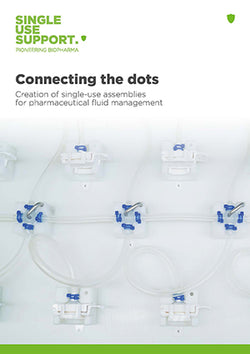PUPSIT - An introduction to pre-use post-sterilization integrity testing
Pre-use post-sterilization integrity testing (PUPSIT) is a crucial step in ensuring the integrity of sterilizing filters used in the biopharmaceutical industry. It is performed to verify a filter’s integrity after it has been installed and sterilized. PUPSIT ensures that an installed filter remains fully functional following the installation and sterilization process and that it complies with all regulatory requirements.
At the same time, the industry’s growing shift toward single-use technology is helping to simplify these processes. Single-use systems arrive pre-sterilized from the supplier; therefore, processes such as autoclaving become unnecessary, reducing both complexity and the potential risks associated with maintaining sterility.
A PUPSIT system for aseptic processing
What is PUPSIT?
PUPSIT is a process used to verify the integrity of a sterilized filter prior to its use in a critical process. This testing is conducted after a filter has been sterilized to confirm that the filter has not been damaged or compromised during the sterilization process. PUPSIT is a crucial step in ensuring the sterility of a final product. It is a commonly used process in the pharmaceutical, biotech, and medical device industries.
Annex 1: Regulatory requirements to perform PUPSIT
PUPSIT is a key regulatory requirement in pharmaceutical manufacturing. It was first introduced by the European Medicines Agency (EMA) in 1997, with the initial version of Annex 1. Following the 2008 revision of Annex 1, regulatory focus on PUPSIT increased considerably.
In line with Current Good Manufacturing Practices (cGMP), various regulatory bodies, including the US Food and Drug Administration (FDA), now require pharmaceutical and biopharmaceutical manufacturers to perform PUPSIT (pre-use post sterilization integrity testing) processes.
The EMA has incorporated PUPSIT into its GMP guidelines for medicinal products, to enhance sterility assurance and minimize the risk of contamination or bioburden. According to standards set by the EMA, FDA, World Health Organization (WHO), Parenteral Drug Association (PDA), International Organization for Standardization (ISO), and other institutions, PUPSIT must be performed after filter sterilization, but both before and after the product filtration process.
The PUPSIT process in detail
Membrane filters have been used in bioprocessing for many years. However, any flaws in a filter can lead to serious issues, such as malfunctions from clogging or cross-contamination caused by incomplete filtration during batch processing.
To avoid these risks, manufacturers must verify the integrity of the membrane filters they use. Given the delicate nature of these membranes, non-destructive integrity testing is required to assess filter performance without causing premature damage.
The PUPSIT procedure is one such non-destructive testing method. By using PUPSIT for integrity testing, manufacturers can ensure that the filters they use are compliant, correctly installed, and remain intact during filtration.
There are three main methods used for PUPSIT, with the most widely used non-destructive integrity test being the Bubble Point Test. It uses water for injection (WFI) that is compliant with ISO standards to moisten the filter. All three different PUPSIT tests can be applied to both filtering options - either using stainless-steel filter housings or single-use systems.

The trend toward single-use technology
While pharmaceutical manufacturing plants have long used fixed piping made of stainless steel for fluid management, medical drug manufacturers are increasingly switching to single-use technologies. One of the main advantages of single-use components is their high degree of compatibility with other single-use components and, consequently, flexibility.
Another advantage is that single-use tubing assemblies are composed of individual, sterilized components, such as connectors, tubes, filters, and bioprocess containers, that can be combined as needed to create a closed system. This means that, unlike with stainless-steel installations, there is no longer any need for autoclaving, thus saving valuable resources.
[[download-1-email-detailed]]
PUPSIT with stainless-steel facilities
Although stainless-steel facilities used in bioprocessing offer some advantages, they also pose several challenges. While certain procedures, such as installation, can be partially automated, the overall setup is more complex and riskier than single-use systems.
Furthermore, the nature of stainless-steel bioreactors requires them to be sterilized and have their filter changed after every processing run. Autoclave sterilization uses steam to kill microorganisms such as bacteria and fungi. This process is essential to prevent contamination and ensure aseptic processing; however, it also leaves water residues.
This poses a problem for many manufacturing facilities: Even the smallest amount of water can dilute any drug being processed and could corrupt the formulation. This could have dire consequences for the end user. Therefore, the biopharmaceutical industry has been seeking alternatives that eliminate the need for autoclaving.
PUPSIT with single-use technology
Such an alternative is now available in the form of single-use technology. Single-use filtration assemblies are composed of various sterile components, including filters, connectors, and tubes. These assemblies are readily customizable to each drug product manufacturing process; therefore, they are ideally suited to replace systems that comprise stainless-steel components.
PUPSIT is compatible with single-use technology and offers considerable advantages over stainless-steel systems, the main one being that with single-use assemblies, the entire system, rather than just the filter, is replaced.
Although filter integrity testing remains a requirement for sterility assurance, autoclaving procedures are no longer necessary to comply with FDA, ISO, or PDA regulations. Therefore, in addition to their increased agility, single-use systems also help mitigate risk by eliminating the need for autoclaving. This ensures that the formulation of a drug product will not be modified by dilution.
Single-use technologies have a further advantage in terms of their sustainability. Compared with stainless-steel components, less water, chemicals, and energy are used in the manufacture of single-use technologies, which is ultimately more environmentally friendly.
Sustainability of single-use technologies - read more!
Ultimately, single-use technologies mean that biomanufacturing and pharmaceutical companies have one less process to worry about for cleanroom compliance and aseptic processing. With single-use systems, suppliers assume responsibility for providing high-quality, sterile components, enabling the end user to rely on the supplier to ensure sterility, thereby reducing the end user’s burden of maintaining these critical standards.
The outlook for PUPSIT
As already mentioned, the pharmaceutical and biopharmaceutical industries are increasingly moving toward single-use assemblies. Higher degrees of flexibility, scalability, and compatibility are among their advantages. Furthermore, single-use manifolds are compatible with PUPSIT integrity testing devices from all established providers.
While pre-use post sterilization integrity testing will remain an integral part of bioprocessing and drug product manufacturing processes, single-use technologies represent a favorable approach to aseptic processing.
They will help simplify not only integrity testing and validation but also manufacturing processes in general, while aligning with cGMP and any standards imposed by stringent authorities such as the FDA and EMA.
Read more about the sterilization of single-use assemblies in this interview with David Seifert: Considerations for sterilization of single-use assemblies.
FAQ
What is PUPSIT?
+
What is PUPSIT?
Pre-use post-sterilization integrity testing (PUPSIT) is a process used to verify the integrity of a sterilized filter before it is used in a critical process to ensure the sterility of the final product.
How is PUPSIT performed?
+
How is PUPSIT performed?
PUPSIT is typically performed by subjecting a sterilized filter to a gas or liquid flow and then measuring the pressure or flow rate across the filter. If the filter is intact, it should retain its integrity and prevent any particles or
microorganisms from passing through.
What is a bubble point test?
+
What is a bubble point test?
A bubble point test is an integrity testing method for filters used in the manufacture of pharmaceutical, biotech, and medical device products. The test involves applying pressure to a filter and then gradually increasing it until a steady stream of bubbles is observed. The pressure at which this occurs is known as the bubble point, and it indicates the minimum pore size of the filter.

Download whitepaper
Whitepaper: IRIS Single-Use Assemblies - Connecting the dots
Throughout the entire manufacturing process, pharmaceutical liquids are transferred and have touchpoints within bioprocessing. Single Use Support provides capabilities with single-use assemblies in
- Dual Sourcing | Strengthening the Supply Chain
- Customization | Developing off-the-shelf assemblies
- Qualification | Providing GMP-compatible solutions
